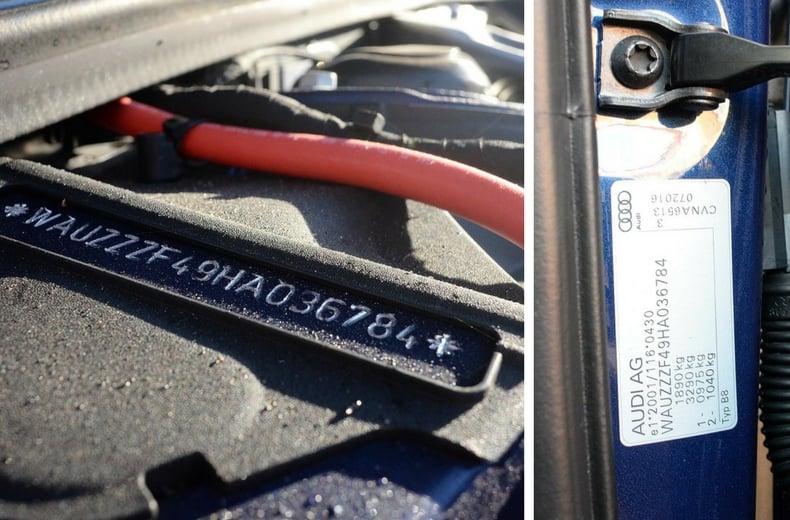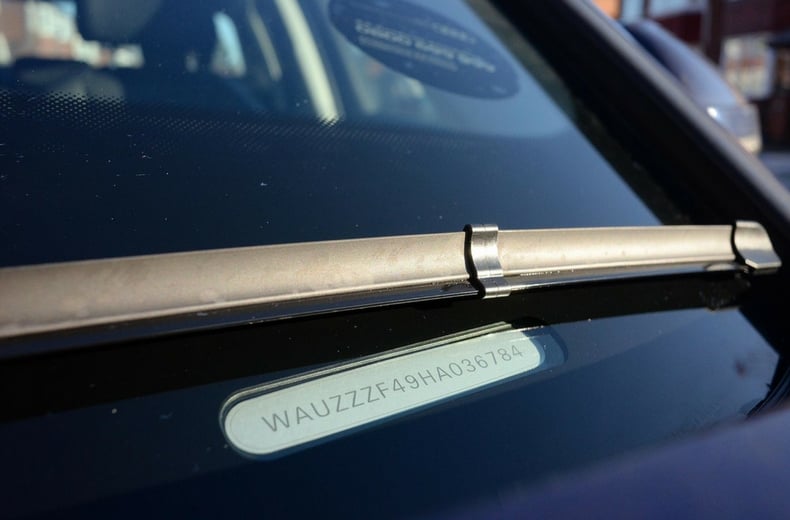A VIN number, or Vehicle Identification Number (typically reffered to as a VIN number even though this is incorrect, much like PIN number) is a 17-digit number stamped into the chassis of a car, that serves as the car's unique identity code.
It is important because it is unique to that car and, unlike registration numbers and other codes, cannot be changed. It is given to a car on the production line and is thus fixed to that car forever.
The first part of the VIN number is the country and manufacturer identifier (for example, ‘WAU’ identifies a German Audi).
The second section is the vehicle description, with the remaining part of the Vehicle Identification Number being the identifier.
5 Star Defaqto rated cover
RAC Comprehensive Car Insurance Plus has been given a 5 Star Rating by Defaqto. Get a quote online today.


Why should you check your vehicle identification number?
Checking a car’s Vehicle Identification Number is the safest way of establishing the true identity of that car and verifying whether a used car is suspect or not.
Car manufacturers and vehicle registration agencies carry databases of these numbers, so they can identify and validate a car accurately, simply by inputting the number.
If you’re buying second-hand, many companies (such as RAC Vehicle Check) offer VIN number check services. If it comes up with irregularities, you can guarantee there’s something not right with that car. Walk away!
Where can you find a vehicle identification number?
The VIN number will be stamped into the chassis of a vehicle, usually found in the engine bay or beneath the plastic trim around the driver or passenger door opening.

Car manufacturers often repeat the VIN number in other areas of the car.
Most models sold in the UK, for example, have a ‘visible VIN’, shown near the bottom of the windscreen.

This allows the police, for example, to run quick and easy identity checks.
VIN numbers are often carried on plates along with other information about the car in question.
When should you check a car’s vehicle identification number?
You should check the Vehicle Identification Number when buying a used car.
Check the the printed VIN number on the V5 vehicle registration document matches the number stamped into the car’s chassis – and also that it matches the number on any other plates located on the car.
Checking the VIN number is one of the most important tasks to carry out when buying a used car.
Manufacturers also use the VIN number to issue car recalls.
What should you do if the VIN number on the car is different from the log book?
If the number on the car doesn’t match the one on the vehicle registration document, don’t buy the car.
Something is not right.
Some unscrupulous types will take the VIN number from one car and transplant it onto another.
This is a highly illegal way to hide stolen cars.
This is known as VIN number cloning.
Criminals will transfer the identity of a legally registered car onto a stolen one.
They will even produce forged documents to hide the car’s identity.
Dangerous ‘Cut and shut’ cars may have a VIN number from two different cars, so if something doesn’t seem right, either check carefully or walk away.
There should be no question marks or uncertainty whatsoever around a car’s vehicle Identification Number; the system is designed to be foolproof and clear.
What’s the difference between a VIN number, a chassis number and an engine number?
A car’s VIN number is sometimes called its chassis number.
They are the same - the Vehicle Identification Number is stamped to the chassis of the car and so is fixed to that model in question.
Car engines are, however, not fixed to the car in question – like other components, they can be changed.
As it is a major component, all cars are given an engine number in addition to a chassis number.
The engine number will denote what size and power output that engine produces.
Having a separate engine number means that if the engine blows up and needs to be replaced, it can be done so without the car needing to be scrapped.
The car will simply be assigned a new engine number, alongside the existing chassis number.
For more buying a car advice visit our car buying guide section.
Services we offer
- Breakdown Cover
- European Breakdown Cover
- Motorbike Breakdown Cover
- Electric Car Breakdown Cover
- Caravan, Motorhome and Campervan Breakdown Cover
- Business Breakdown Cover
- Van Breakdown Cover
- RAC Approved Garages
- Vehicle servicing
- Vehicle repair
- MOTs
- Mobile mechanics
- RAC Tyres
- RAC Approved Dealers
- RAC Warranty
- RAC Shop
- myRAC app







